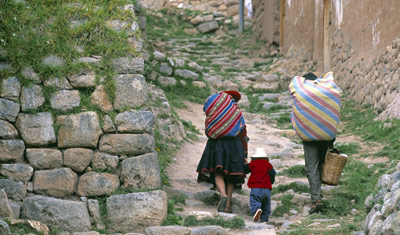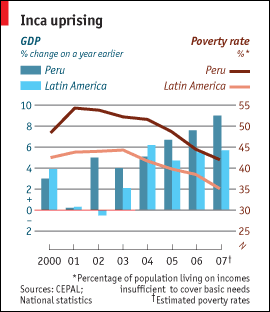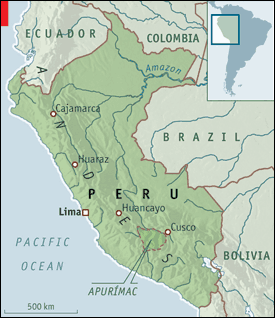
(Photo: Corbis)
Poverty amid progress
A revolution in South America's fastest-growing economy is not reaching everyone
May 8th 2008 - Economist.com
From The Economist print edition
LIMA -- BLOCKS of flats or offices are under construction on nearly every street. New hotels and restaurants sprout on every corner, while shopping centres multiply in what were once shantytowns. Across the city, thoroughfares have been torn up to make way for new bus lanes and terminals. Such is the anarchic volume of traffic that just crossing the street has become a time-consuming and perilous exercise. Lima, Peru's capital of 8m people, is shedding its former air of provincial lassitude and turning into a bustling metropolis.
 The city is the visible face of a boom that has made Peru South America's fastest-growing economy (see chart). That performance owes much to record prices for mineral exports. But newer export products, from designer cotton T-shirts to mangoes and artichokes, are also flourishing. As well as trade, private investment, growing at 20% a year, and domestic consumption are driving the economy forward at an accelerating pace (in the year to February, GDP grew by 9.2%).
The city is the visible face of a boom that has made Peru South America's fastest-growing economy (see chart). That performance owes much to record prices for mineral exports. But newer export products, from designer cotton T-shirts to mangoes and artichokes, are also flourishing. As well as trade, private investment, growing at 20% a year, and domestic consumption are driving the economy forward at an accelerating pace (in the year to February, GDP grew by 9.2%).
Thanks to high world prices for food and fuel, inflation has spiked to 5.5%, having been low for years. Nevertheless, the growth looks to be built on solid foundations. The national savings rate has risen to 24% of GDP, high by regional standards, and the government last year posted a fiscal surplus of 3% of GDP. A free-trade agreement with the United States is about to come into effect. In recognition of such achievements, Peru's debt was awarded an investment-grade credit rating last month by Fitch, a ratings agency.
Yet there are paradoxes at the heart of the boom. Despite the growth, poverty has fallen only slowly. And many Peruvians are disgruntled. The president, Alan García, was once a radical populist who presided over hyperinflation and debt default in a first term in office in the 1980s. He returned to office in 2006 a reformed character. But his people give him little credit for the strong economy. He is one of the least popular presidents in Latin America, with an approval rating of just 26% in a poll taken in the main cities in April by Ipsos-Apoyo, a pollster.
There are several reasons for the relatively slow fall in poverty. Although the number of formal-sector jobs is expanding at 9% a year, many Peruvians still labour in the informal sector of unregistered businesses, where productivity is low. Wages for the unskilled have been slow to rise.
A bigger reason is geography. The capital, the Pacific coastal strip and most of the north of the country are all thriving. The problem is the southern Andean region, where poverty reaches 70% of the population. Helped by tourism, mining and microcredit some Andean cities, such as Cajamarca, Cusco, Huaraz and Huancayo, are prospering. The big divorce is with the surrounding, often mountainous, countryside, where many Andean Indians remain trapped in subsistence farming on small plots. Whereas 60% of the labour force in Lima are waged workers, only 27% are in Apurímac, notes Efraín González, an economist at Lima's Catholic University.
These unwaged people are often more or less cut off from the market economy. And it is market connections that make economic growth “trickle down” to the poor, points out Richard Webb, a social researcher and former central-bank governor. Enabling that to happen is thus a job for public policy. Better roads, education and social policy are all needed.
 At least in theory, Mr García's government recognises this. It has set an ambitious target of cutting poverty to 30% by the end of its term, in 2011. For the first time in three decades the state has money to invest—but it is finding it hard to do so.
At least in theory, Mr García's government recognises this. It has set an ambitious target of cutting poverty to 30% by the end of its term, in 2011. For the first time in three decades the state has money to invest—but it is finding it hard to do so.
With the help of the World Bank, the government has drawn up a new anti-poverty strategy which focuses on trying to end the malnutrition that affects 30% of Peruvian children, most of them in the southern Andes. It has ramped up social spending while trying to target it more closely on the poorest areas. But Ivan Hidalgo, the official in charge, accepts that a lack of good managers, especially in local governments, is hindering this effort. He does not add that, in a misguided gesture, Mr García slashed salaries for top public-sector jobs.
Similarly, money for public investment in roads or to help farmers lies unspent at all levels of government, partly because of fears of corruption. In another paradox, Peru has created “a culture of fiscal propriety” whose side-effect is that officials are ignoring a social emergency in the Andes, says Mr Webb.
Tackling this effectively means reforming the education and health ministries as well as local government. Mr García's government has made some effort to improve the performance of teachers, but has otherwise done little. “It's a government that insists on investment and not on reforms,” says Julio Cotler, a sociologist at Lima's Institute of Peruvian Studies.
Like his predecessor, Alejandro Toledo, Mr García is handicapped by his unpopularity and by his lack of a legislative majority. In the presidential election, the southern Andes voted heavily for Ollanta Humala, a populist former army officer. According to Ipsos-Apoyo, Mr Humala is today more popular than the president. “To be popular in Peru you need a populist discourse,” says Mr Cotler. “It doesn't get anyone out of poverty but it soothes people's rancour and resentments.”
Nevertheless, the economic boom is going hand in hand with a deeper cultural change. In the 1970s and 1980s, Peru was a collectivist country: first a military government nationalised much of the economy and then Mr García, in his first term, took over a chunk more, egged on by a powerful left-wing opposition. Since then Peru has undergone a “capitalist revolution”, as Jaime de Althaus, a liberal journalist, argues in a recent book. This revolution is based not just on big mining companies, but on thousands of small-scale farmers on the coast, who broke up their state co-operatives into commercial plots, and on small businessmen in the shanty towns, who are exporting everything from clothes to electrical components.
When leftists complain the capitalism is “savage” they sometimes have a point: while some companies post record profits, many Peruvians work long hours for low wages with few labour rights. Away from Lima and the north coast, which have embraced globalisation, many Peruvians cling to nationalist and statist attitudes, says Alfredo Torres of Ipsos-Apoyo. Unless the politicians do a better job of defending the capitalist revolution and spreading its benefits, it will be threatened by the rancour of those who feel left out.